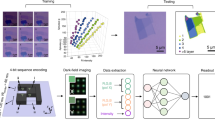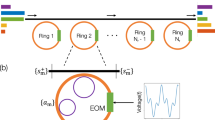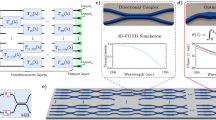Abstract
Recent years have seen the rapid growth and development of the field of smart photonics, where machine-learning algorithms are being matched to optical systems to add new functionalities and to enhance performance. An area where machine learning shows particular potential to accelerate technology is the field of ultrafast photonics — the generation and characterization of light pulses, the study of light–matter interactions on short timescales, and high-speed optical measurements. Our aim here is to highlight a number of specific areas where the promise of machine learning in ultrafast photonics has already been realized, including the design and operation of pulsed lasers, and the characterization and control of ultrafast propagation dynamics. We also consider challenges and future areas of research.
This is a preview of subscription content, access via your institution
Access options
Access Nature and 54 other Nature Portfolio journals
Get Nature+, our best-value online-access subscription
$29.99 / 30 days
cancel any time
Subscribe to this journal
Receive 12 print issues and online access
$209.00 per year
only $17.42 per issue
Buy this article
- Purchase on Springer Link
- Instant access to full article PDF
Prices may be subject to local taxes which are calculated during checkout



Similar content being viewed by others
References
Jordan, M. I. & Mitchell, T. M. Machine learning: trends, perspectives, and prospects. Science 349, 255–260 (2015).
Mahlab, U., Shamir, J. & Caulfield, H. J. Genetic algorithm for optical pattern recognition. Opt. Lett. 16, 648–650 (1991).
Kihm, K. D. & Lyons, D. P. Optical tomography using a genetic algorithm. Opt. Lett. 21, 1327–1329 (1996).
Albert, O., Sherman, L., Mourou, G., Norris, T. B. & Vdovin, G. Smart microscope: an adaptive optics learning system for aberration correction in multiphoton confocal microscopy. Opt. Lett. 25, 52–54 (2000).
Eisenhammer, T., Lazarov, M., Leutbecher, M., Schöffel, U. & Sizmann, R. Optimization of interference filters with genetic algorithms applied to silver-based heat mirrors. Appl. Opt. 32, 6310–6315 (1993).
Martin, S., Rivory, J. & Schoenauer, M. Synthesis of optical multilayer systems using genetic algorithms. Appl. Opt. 34, 2247–2254 (1995).
Zibar, D., Wymeersch, H. & Lyubomirsky, I. Machine learning under the spotlight. Nat. Photon. 11, 749–751 (2017).
Zhou, J., Huang, B., Yan, Z. & Bünzli, J.-C. G. Emerging role of machine learning in light-matter interaction. Light Sci. Appl. 8, 84 (2019).
Nadell, C. C., Huang, B., Malof, J. M. & Padilla, W. J. Deep learning for accelerated all-dielectric metasurface design. Opt. Express 27, 27523–27535 (2019).
Malkiel, I. et al. Plasmonic nanostructure design and characterization via deep learning. Light Sci. Appl. 7, 60 (2018).
Hegde, R. S. Deep learning: a new tool for photonic nanostructure design. Nanoscale Adv. 2, 1007–1023 (2020).
Chen, C. L. et al. Deep learning in label-free cell classification. Sci. Rep. 6, 21471 (2016).
Ouyang, W., Aristov, A., Lelek, M., Hao, X. & Zimmer, C. Deep learning massively accelerates super-resolution localization microscopy. Nat. Biotechnol. 36, 460–468 (2018).
Durand, A. et al. A machine learning approach for online automated optimization of super-resolution optical microscopy. Nat. Commun. 9, 5247 (2018).
Palmieri, A. M. et al. Experimental neural network enhanced quantum tomography. npj Quantum Inf. 6, 20 (2020).
Zibar, D., Piels, M., Jones, R. & Schäeffer, C. G. Machine learning techniques in optical communication. J. Lightwave Technol. 34, 1442–1452 (2016).
Musumeci, F. et al. An overview on application of machine learning techniques in optical networks. IEEE Commun. Surv. Tutorials 21, 1383–1408 (2019).
Lugnan, A. et al. Photonic neuromorphic information processing and reservoir computing. APL Photon. 5, 020901 (2020).
Knox, W. H. Ultrafast technology in telecommunications. IEEE J. Sel. Top. Quantum Electron. 6, 1273–1278 (2000).
Sibbett, W., Lagatsky, A. A. & Brown, C. T. A. The development and application of femtosecond laser systems. Opt. Express 20, 6989–7001 (2012).
Sugioka, K. & Cheng, Y. Ultrafast lasers — reliable tools for advanced materials processing. Light Sci. Appl. 3, e149 (2014).
Fermann, M. E., Galvanauskas, A. & Sucha, G. Ultrafast Lasers: Technology and Applications Vol. 80 (CRC Press, 2002).
Xu, C. & Wise, F. W. Recent advances in fibre lasers for nonlinear microscopy. Nat. Photon. 7, 875–882 (2013).
Grelu, P. & Akhmediev, N. Dissipative solitons for mode-locked lasers. Nat. Photon. 6, 84–92 (2012).
Richardson, D. J., Nilsson, J. & Clarkson, W. A. High power fiber lasers: current status and future perspectives. J. Opt. Soc. Am. B 27, B63–B92 (2010).
Fermann, M. E. & Hartl, I. Ultrafast fibre lasers. Nat. Photon. 7, 868–874 (2013).
Fu, X. & Kutz, N. J. High-energy mode-locked fiber lasers using multiple transmission filters and a genetic algorithm. Opt. Express 21, 6526–6537 (2013).
Fu, X., Brunton, S. L. & Kutz, J. N. Classification of birefringence in mode-locked fiber lasers using machine learning and sparse representation. Opt. Express 22, 8585–8597 (2014).
Kutz, J. N. & Brunton, S. L. Intelligent systems for stabilizing mode-locked lasers and frequency combs: machine learning and equation-free control paradigms for self-tuning optics. Nanophotonics 4, 459–471 (2015).
Baumeister, T., Brunton, S. L. & Kutz, J. N. Deep learning and model predictive control for self-tuning mode-locked lasers. J. Opt. Soc. Am. B 35, 617–626 (2018).
Andral, U. et al. Fiber laser mode locked through an evolutionary algorithm. Optica 2, 275–278 (2015).
Andral, U. et al. Toward an autosetting mode-locked fiber laser cavity. J. Opt. Soc. Am. B 33, 825–833 (2016).
Woodward, R. & Kelleher, E. Towards smart lasers: self-optimisation of an ultrafast pulse source using a genetic algorithm. Sci. Rep. 6, 37616 (2016).
Woodward, R. & Kelleher, E. Genetic algorithm-based control of birefringent filtering for self-tuning, self-pulsing fiber lasers. Opt. Lett. 42, 2952–2955 (2017).
Winters, D. G., Kirchner, M. S., Backus, S. J. & Kapteyn, H. C. Electronic initiation and optimization of nonlinear polarization evolution mode-locking in a fiber laser. Opt. Express 25, 33216–33225 (2017).
Kokhanovskiy, A., Ivanenko, A., Kobtsev, S., Smirnov, S. & Turitsyn, S. Machine learning methods for control of fibre lasers with double gain nonlinear loop mirror. Sci. Rep. 9, 2916 (2019).
Meng, F. & Dudley, J. M. Towards a self-driving ultrafast fiber laser. Light Sci. Appl. 9, 26 (2020).
Pu, G., Yi, L., Zhang, L. & Hu, W. Intelligent programmable mode-locked fiber laser with a human-like algorithm. Optica 6, 362–369 (2019).
Pu, G., Yi, L., Zhang, L. & Hu, W. Genetic algorithm-based fast real-time automatic mode-locked fiber laser. IEEE Photon. Technol. Lett. 32, 7–10 (2020).
Kokhanovskiy, A. et al. Machine learning-based pulse characterization in figure-eight mode-locked lasers. Opt. Lett. 44, 3410–3413 (2019).
Pu, G. et al. Intelligent control of mode-locked femtosecond pulses by time-stretch-assisted real-time spectral analysis. Light Sci. Appl. 9, 13 (2020).
Farfan, C. A., Epstein, J. & Turner, D. B. Femtosecond pulse compression using a neural-network algorithm. Opt. Lett. 43, 5166–5169 (2018).
Finot, C., Gukov, I., Hammani, K. & Boscolo, S. Nonlinear sculpturing of optical pulses with normally dispersive fiber-based devices. Opt. Fiber Technol. 45, 306–312 (2018).
Zhang, W. Q., Afshar, S. & Monro, T. M. A genetic algorithm based approach to fiber design for high coherence and large bandwidth supercontinuum generation. Opt. Express 17, 19311–19327 (2009).
Arteaga-Sierra, F. R. et al. Supercontinuum optimization for dual-soliton based light sources using genetic algorithms in a grid platform. Opt. Express 22, 23686–23693 (2014).
Michaeli, L. & Bahabad, A. Genetic algorithm driven spectral shaping of supercontinuum radiation in a photonic crystal fiber. J. Opt. 20, 055501 (2018).
Wetzel, B. et al. Customizing supercontinuum generation via on-chip adaptive temporal pulse-splitting. Nat. Commun. 9, 4884 (2018).
Ryczkowski, P. et al. Real-time full-field characterization of transient dissipative soliton dynamics in a mode-locked laser. Nat. Photon. 12, 221–227 (2018).
Kamilov, U. S. et al. Learning approach to optical tomography. Optica 2, 517–522 (2015).
Rivenson, Y., Wu, Y. & Ozcan, A. Deep learning in holography and coherent imaging. Light Sci. Appl. 8, 85 (2019).
Borhani, N., Kakkava, E., Moser, C. & Psaltis, D. Learning to see through multimode fibers. Optica 5, 960–966 (2018).
Li, Y., Xue, Y. & Tian, L. Deep speckle correlation: a deep learning approach toward scalable imaging through scattering media. Optica 5, 1181–1190 (2018).
Liu, T. et al. Deep learning-based super-resolution in coherent imaging systems. Sci. Rep. 9, 3926 (2019).
Krumbügel, M. A. et al. Direct ultrashort-pulse intensity and phase retrieval by frequency-resolved optical gating and a computational neural network. Opt. Lett. 21, 143–145 (1996).
Nicholson, J., Omenetto, F., Funk, D. J. & Taylor, A. Evolving FROGS: phase retrieval from frequency-resolved optical gating measurements by use of genetic algorithms. Opt. Lett. 24, 490–492 (1999).
Shu, S. F. Evolving ultrafast laser information by a learning genetic algorithm combined with a knowledge base. IEEE Photon. Technol. Lett. 18, 379–381 (2006).
Zahavy, T. et al. Deep learning reconstruction of ultrashort pulses. Optica 5, 666–673 (2018).
Kleinert, S., Tajalli, A., Nagy, T. & Morgner, U. Rapid phase retrieval of ultrashort pulses from dispersion scan traces using deep neural networks. Opt. Lett. 44, 979–982 (2019).
Xiong, W. et al. Deep learning of ultrafast pulses with a multimode fiber. APL Photonics 5, 096106 (2020).
Rivenson, Y., Zhang, Y., Günaydın, H., Teng, D. & Ozcan, A. Phase recovery and holographic image reconstruction using deep learning in neural networks. Light Sci. Appl. 7, 17141 (2018).
Sinha, A., Lee, J., Li, S. & Barbastathis, G. Lensless computational imaging through deep learning. Optica 4, 1117–1125 (2017).
Wu, Y. et al. Extended depth-of-field in holographic imaging using deep-learning-based autofocusing and phase recovery. Optica 5, 704–710 (2018).
Goy, A., Arthur, K., Li, S. & Barbastathis, G. Low photon count phase retrieval using deep learning. Phys. Rev. Lett. 121, 243902 (2018).
Sanchez-Gonzalez, A. et al. Accurate prediction of X-ray pulse properties from a free-electron laser using machine learning. Nat. Commun. 8, 15461 (2017).
White, J. & Chang, Z. Attosecond streaking phase retrieval with neural network. Opt. Express 27, 4799–4807 (2019).
Raissi, M. Deep hidden physics models: deep learning of nonlinear partial differential equations. J. Mach. Learn. Res. 19, 932–955 (2018).
Raissi, M., Perdikaris, P. & Karniadakis, G. E. Physics-informed neural networks: a deep learning framework for solving forward and inverse problems involving nonlinear partial differential equations. J. Comput. Phys. 378, 686–707 (2019).
Brunton, S. L., Proctor, J. L. & Kutz, J. N. Discovering governing equations from data by sparse identification of nonlinear dynamical systems. Proc. Natl Acad. Sci. USA 113, 3932–3937 (2016).
Jiang, J. & Lai, Y.-C. Model-free prediction of spatiotemporal dynamical systems with recurrent neural networks: role of network spectral radius. Phys. Rev. Res. 1, 033056 (2019).
Salmela, L. et al. Predicting ultrafast nonlinear dynamics in fibre optics with a recurrent neural network. Preprint at https://arxiv.org/abs/2004.14126 (2020).
Lapre, C. et al. Real-time characterization of spectral instabilities in a mode-locked fibre laser exhibiting soliton-similariton dynamics. Sci. Rep. 9, 13950 (2019).
Dudley, J. M., Genty, G., Mussot, A., Chabchoub, A. & Dias, F. Rogue waves and analogies in optics and oceanography. Nat. Rev. Phys. 1, 675–689 (2019).
Närhi, M. et al. Real-time measurements of spontaneous breathers and rogue wave events in optical fibre modulation instability. Nat. Commun. 7, 13675 (2016).
Tikan, A., Bielawski, S., Szwaj, C., Randoux, S. & Suret, P. Single-shot measurement of phase and amplitude by using a heterodyne time-lens system and ultrafast digital time-holography. Nat. Photon. 12, 228–234 (2018).
Närhi, M. et al. Machine learning analysis of extreme events in optical fibre modulation instability. Nat. Commun. 9, 4923 (2018).
Salmela, L., Lapre, C., Dudley, J. M. & Genty, G. Machine learning analysis of rogue solitons in supercontinuum generation. Sci. Rep. 10, 9596 (2020).
Amil, P., Soriano, M. C. & Masoller, C. Machine learning algorithms for predicting the amplitude of chaotic laser pulses. Chaos 29, 113111 (2019).
Cunillera, A., Soriano, M. C. & Fischer, I. Cross-predicting the dynamics of an optically injected single-mode semiconductor laser using reservoir computing. Chaos 29, 113113 (2019).
Vlachas, P. et al. Backpropagation algorithms and reservoir computing in recurrent neural networks for the forecasting of complex spatiotemporal dynamics. Neural Netw. 126, 191–217 (2020).
Pathak, J., Hunt, B., Girvan, M., Lu, Z. & Ott, E. Model-free prediction of large spatiotemporally chaotic systems from data: a reservoir computing approach. Phys. Rev. Lett. 120, 024102 (2018).
Teğin, U. et al. Controlling spatiotemporal nonlinearities in multimode fibers with deep neural networks. APL Photon. 5, 030804 (2020).
Comin, A. & Hartschuh, A. Efficient optimization of SHG hotspot switching in plasmonic nanoantennas using phase-shaped laser pulses controlled by neural networks. Opt. Express 26, 33678–33686 (2018).
Diddams, S. A. The evolving optical frequency comb. J. Opt. Soc. Am. B 27, B51–B62 (2010).
Assion, A. et al. Control of chemical reactions by feedback-optimized phase-shaped femtosecond laser pulses. Science 282, 919–922 (1998).
Bartels, R. et al. Shaped-pulse optimization of coherent emission of high-harmonic soft X-rays. Nature 406, 164–166 (2000).
Herek, J. L., Wohlleben, W., Cogdell, R. J., Zeidler, D. & Motzkus, M. Quantum control of energy flow in light harvesting. Nature 417, 533–535 (2002).
Davies, R. & Kasper, M. Adaptive optics for astronomy. Annu. Rev. Astron. Astrophys. 50, 305–351 (2012).
Florentin, R. et al. Shaping the light amplified in a multimode fiber. Light Sci. Appl. 6, e16208 (2017).
Florentin, R., Kermene, V., Desfarges-Berthelemot, A. & Barthelemy, A. Space-time adaptive control of femtosecond pulses amplified in a multimode fiber. Opt. Express 26, 10682–10690 (2018).
Liu, B. & Weiner, A. M. Space–time focusing in a highly multimode fiber via optical pulse shaping. Opt. Lett. 43, 4675–4678 (2018).
Hughes, T. W., Minkov, M., Williamson, I. A. D. & Fan, S. Adjoint method and inverse design for nonlinear nanophotonic devices. ACS Photon. 5, 4781–4787 (2018).
Goodfellow, I. J. et al. Generative adversarial nets. Adv. Neural Inf. Process. Syst. 3, 2672–2680 (2014).
Subramaniam, A., Wong, M. L., Borker, R. D., Nimmagadda, S. & Lele, S. K. Turbulence enrichment using physics-informed generative adversarial networks. Preprint at https://arxiv.org/abs/2003.01907 (2020).
Van Rullen, R. & Thorpe, S. J. Rate coding versus temporal order coding: what the retinal ganglion cells tell the visual cortex. Neural Comput. 13, 1255–1283 (2001).
Diamond, A., Schmuker, M. & Nowotny, T. An unsupervised neuromorphic clustering algorithm. Biol. Cybern. 113, 423–437 (2019).
Lin, X. et al. All-optical machine learning using diffractive deep neural networks. Science 361, 1004–1008 (2018).
Shen, Y. et al. Deep learning with coherent nanophotonic circuits. Nat. Photon. 11, 441–446 (2017).
Fang, M. Y.-S., Manipatruni, S., Wierzynski, C., Khosrowshahi, A. & DeWeese, M. R. Design of optical neural networks with component imprecisions. Opt. Express 27, 14009–14029 (2019).
Young, S. R., Rose, D. C., Karnowski, T. P., Lim, S.-H. & Patton, R. M. Optimizing deep learning hyper-parameters through an evolutionary algorithm. In Proc. Workshop on Machine Learning in High-Performance Computing Environments 1–5 (ACM, 2015).
Penkovsky, B., Larger, L. & Brunner, D. Efficient design of hardware-enabled reservoir computing in FPGAs. J. Appl. Phys. 124, 162101 (2018).
Klein, A., Falkner, S., Bartels, S., Hennig, P. & Hutter, F. Fast Bayesian hyperparameter optimization on large datasets. Electron. J. Stat. 11, 4945–4968 (2017).
Antonik, P., Marsal, N., Brunner, D. & Rontani, D. Bayesian optimisation of large-scale photonic reservoir computers. Preprint at https://arxiv.org/abs/2004.02535 (2020).
Meng, F., Lapre, C., Billet, C., Genty, G. & Dudley, J. M. Instabilities in a dissipative soliton-similariton laser using a scalar iterative map. Opt. Lett. 45, 1232–1235 (2020).
Acknowledgements
G.G. acknowledges the Academy of Finland (318082, 333949, Flagship PREIN 320165). L.S. acknowledges the Faculty of Engineering and Natural Sciences graduate school of Tampere University. J.M.D. and D.B. were supported by the EUR EIPHI and I-SITE BFC projects (contracts ANR-17-EURE-0002 and ANR-15-IDEX- 0003). D.B. also acknowledges funding from the Volkswagen Foundation and from the French Agence Nationale de la Recherche (ANR-19-CE24-0006-02). The work of S.K.T. and A.K. was supported by the Russian Science Foundation (grant number 17-72-30006). S.K.T. acknowledges the support of the EPSRC project TRANSNET. The work of S.K. was supported by the Russian Foundation for Basic Research grant number 18-29-20025.
Author information
Authors and Affiliations
Corresponding author
Ethics declarations
Competing interests
The authors declare no competing interests.
Additional information
Publisher’s note Springer Nature remains neutral with regard to jurisdictional claims in published maps and institutional affiliations.
Rights and permissions
About this article
Cite this article
Genty, G., Salmela, L., Dudley, J.M. et al. Machine learning and applications in ultrafast photonics. Nat. Photonics 15, 91–101 (2021). https://doi.org/10.1038/s41566-020-00716-4
Received:
Accepted:
Published:
Issue Date:
DOI: https://doi.org/10.1038/s41566-020-00716-4
This article is cited by
-
Optimizing ultrashort pulse in fiber laser based on artificial intelligence algorithm
Scientific Reports (2024)
-
Potential of photonic crystal fiber for designing optical devices for telecommunication networks
Optical and Quantum Electronics (2024)
-
Investigation of Random Laser in the Machine Learning Approach
Brazilian Journal of Physics (2024)
-
Inverse design of high efficiency and large bandwidth power splitter for arbitrary power ratio based on deep residual network
Optical and Quantum Electronics (2024)
-
Intelligent optoelectronic processor for orbital angular momentum spectrum measurement
PhotoniX (2023)



